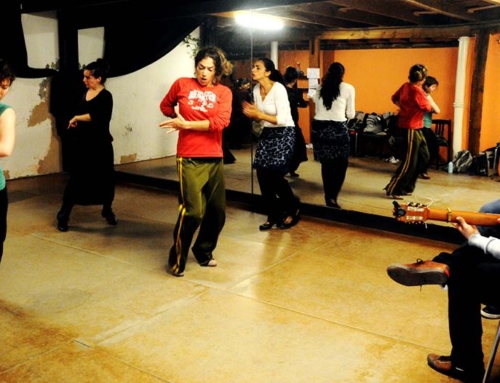I am going to try to write a little bit about each show I see at the Bienal de Flamenco. Here it goes with the first show I’ve seen…
María Pagés, ‘Utopía’
This woman’s arms will never cease to amaze me. Never.
There is something about Maria Pages that makes me feel like she is completely free while she is dancing. I don’t know what it is in dance—it’s what we strive for, to have so much control so much feeling and musicality in every cell of the body that it appears as if the body is moving of its own accord, that it is not constrained to exact movements or shapes, but rather is set completely free—when in reality it is the exact opposite. That’s what we strive for—the freedom of expression that can only come with precision in every ounce of muscle, and Pagés accomplishes that.
The guajiras was one of the most beautiful interpretations of this palo that I have ever seen. I do not usually think of Pages as being particularly feminine—in fact, quite the opposite. She has no waist, no hips—she is long and slender and straight. But in this piece she was bursting with femininity and flirtatiousness—if I didn’t know better I would think she was a teenager in love for the first time. The way she used her shoulders and her hips gave the illusion that she had curves—which went along with the theme of the show, “La que me atrae es la curva libre y sensual” (Oscar Niemeyer).
Last year in New York, her use of the mantón (shawl) blew me away—only her long slender arms could control the heavy fabric so flawlessly and bring it alive. In ‘Utopía,’ she amazed me equally so with the twists and spirals of her red fan. It became like a cardinal flapping its wings rapidly in time with the undulations of the rest of her body. I swear it seemed like it was alive. The three other women danced equally beautiful. The piece begins with them facing in towards one another open their fans sharply. Then they flawlessly would open them in such a way that a perfect circle was made by two of the fans—one fan open and facing down and the other open and facing up. That resulted in a few gasps of awe from the audience.
There were many moments in the performance in which the music was travelling at a high velocity, with the palmas (handclaps) doing contra tiempo or double time, yet at the same time the dancers would be moving slowly although in time. Somehow no energy was lost. Pages did not feel a need to speed with the music, but instead knows how to truly use the music to highlight the movements of the dancers.
Here’s a question I am left with though, and this relates specifically to my Fulbright project:
The show is based on a series of themes. Part of the program reads;
“Un proyecto global en el que siete bailaores interpretan junto a Pagés la experiencia ética y estética del deseo, del inconformismo y de la utopia…
“’Utopia’ es, en su esencia, el titulo de una danza poetizada que se estructura en ocho partes (o versos) que convocan poemas de Baudelaire, Benedetti, Neruda, Machado, Larbi El Harti, y el propio Niemeyer, incorporando además palabras del Quijote de Cervantes.”
So my question is, would this come through if I had not read the program? Is it necessary to write that all out—for the audience to read that before they see the show? Or should the show explain itself? Not that anything that specific could be garnered, but wouldn’t the essence of that all come through without the explanation?
I feel like all great artists have a story, an inspiration, what Twyla Tharp calls the backbone, and sometimes that backbone makes itself perfectly clear and is not in the least bit abstract, and other times it is completely hidden by the flesh of the show, and we simply know it is there and extract that it is there (either consciously or subconsciously) because we know something is holding up what we see.
I think as well, that as long as the audience member listens to the lyrics, much of the theme can be known exactly. Not that the letras give it away, but as literature they give us a more concrete ability to find the abstract within the metaphors.
I want to know how exactly Pages and others that incorporate non-flamenco poetry and literature into flamenco. Is the singer responsible for its conversion to flamenco? I want to know more about her creative process and the collaboration between the various disciplines of artists.
For more about the show go to: http://www.mariapages.com/en_utopia.html
and here is a video clip too:





Leave A Comment